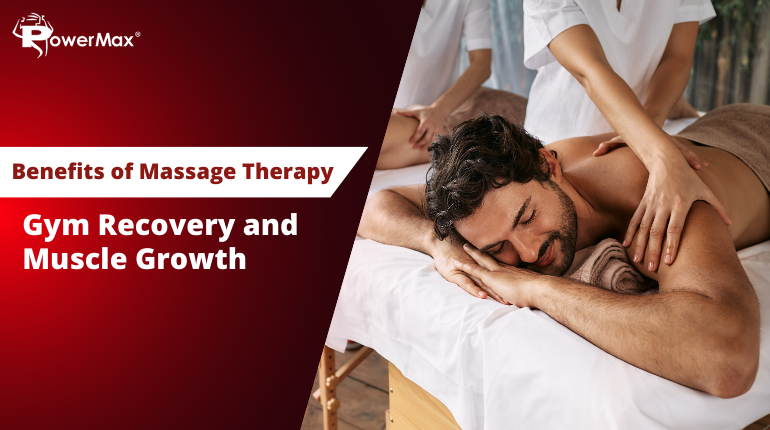Introduction: The Benefits Of Massage Therapy
You may think of massage therapy as just a luxury indulgence, but the benefits of massage therapy extend deep into enhancing gym recovery, improving sleep, and promoting muscle growth. For those dedicated to achieving peak performance and long-term results, understanding how massage therapy supports these goals is essential.
In this guide, we’ll break down the various ways massage therapy can optimize your fitness routine, focusing on rest and recovery, sleep improvement, and muscle growth. Let's dive in and uncover how you can maximize your gains with this powerful tool.
Rest and Recovery: The Foundation of Growth
While intense workouts break down muscle fibers, the true progress happens during recovery. Incorporating massage therapy into your post-gym routine offers the following benefits:
1. Reduces Muscle Soreness (DOMS)
Delayed Onset Muscle Soreness (DOMS) can slow you down, especially after intense leg days or heavy lifting sessions. Massage therapy helps by Increasing blood flow to sore areas.
- Removing lactic acid buildup.
- Promoting faster tissue repair.
Imagine completing an intense deadlift session, only to struggle walking the next day. A targeted massage can ease tension in your hamstrings and glutes, reducing pain and improving mobility.
2. Improves Flexibility and Range of Motion
Tight muscles restrict your performance and can increase the risk of injury. Regular massages:
- Loosen stiff muscle fibers.
- Enhance joint mobility.
- Prepare your body for the next workout.
- Pro Tip: Combine massage therapy with foam rolling to maximize flexibility gains.
3. Boosts Circulation
Better circulation means more oxygen and nutrients reach your muscles, which speeds up recovery. Massage therapy stimulates blood flow, ensuring your muscles heal effectively and are ready for the next challenge. We also have the best massager chairs such as full body massager, foot massager, calf massager.
Sleep and Recovery: The Hidden Gains
It's during deep sleep that your body repairs damaged muscle tissues and produces growth hormones. However, stress, muscle tension, and poor sleep hygiene can derail this process. Here’s where massage therapy comes in.
1. Promotes Relaxation and Reduces Stress
Cortisol, the stress hormone, is the enemy of muscle growth and recovery. Massage therapy lowers cortisol levels. It also boosts serotonin and dopamine (happy hormones), creating a calming effect to prepare you for a restful sleep. For example, after an intense CrossFit session, a relaxing Swedish massage can soothe your nervous system and transition your body into recovery mode.
2. Improves Sleep Quality
Massage therapy triggers the parasympathetic nervous system (your body’s "rest and digest" mode). Additionally, it reduces muscle tension that keeps you tossing and turning. Pro Tip: A 20-minute massage before bed can act as a natural sleep aid, helping you wake up rejuvenated.
3. Supports Recovery During Deep Sleep
Deep sleep is when your body does the heavy lifting of muscle growth and immune system strengthening. Massage therapy primes your body to achieve this stage of sleep faster and for longer durations. Moreover, it aids in muscle building by improving the physiological processes that lead to muscle hypertrophy (muscle size increase).
Muscle Growth: Building Your Dream Physique
Muscle growth isn’t just about lifting heavy—it’s also about optimizing recovery and muscle repair.
1. Enhances Protein Synthesis
Protein synthesis is the process by which your body repairs and builds muscle fibers. Essential nutrients like amino acids are delivered efficiently to your muscles through the increase in blood flow. Moreover, inflammation can hinder muscle repair. Post-workout massages can speed up protein synthesis, allowing you to return to the gym stronger and more resilient.
2. Reduces Inflammation
Intense workouts can lead to microscopic tears in your muscle fibers, causing inflammation. The release of anti-inflammatory agents is promoted by massage therapy. This creates an optimal environment for muscle recovery and growth.
3. Improves Muscle Activation
Tight or fatigued muscles can struggle to perform optimally during workouts. Now, massage therapy ensures greater muscle activation during exercises, better form, and reduced risk of injury. Combine with active stretching to ensure your muscles are prepped for heavy lifting days.
Secondary Benefits of Massage Therapy for Gym Enthusiasts
In addition to the primary benefits above, massage therapy offers numerous secondary perks that complement your fitness goals:
Boosts Immune Function: Regular massages can strengthen your immune system, helping you recover faster from illnesses that may disrupt your gym routine.
Supports Mental Clarity: Relaxed muscles lead to a relaxed mind, improving focus and motivation for your workouts.
Reduces Scar Tissue: Deep tissue massages can break down scar tissue from previous injuries, improving muscle functionality.
How to Incorporate Massage Therapy into Your Routine
Post-Workout Recovery: Schedule a sports massage within 24–48 hours after an intense session.
Pre-Workout Preparation: Use a quick 10–15 minute massage to loosen up tight muscles and improve performance.
Active Recovery Days: Dedicate one of your recovery days to a full-body massage to reset your body and mind.
DIY Techniques: Can’t visit a therapist? Use massage tools like foam rollers or massage guns to target sore areas.
Conclusion: Why Massage Therapy Is Essential for Gym Recovery
The benefits of massage therapy go far beyond relaxation—it’s a crucial tool for anyone serious about their gym progress. From speeding up recovery and improving sleep to enhancing muscle growth, this therapy offers a comprehensive approach to maximizing your fitness potential.
Making massage a part of your routine can enhance your performance and results. So, the next time you hit the weights or conquer a cardio session, remember that recovery isn’t just about rest—it’s about smart recovery. Incorporate massage therapy into your fitness journey and experience the difference in your recovery, sleep, and muscle gains. Your body will thank you for it.
 India (INR)
India (INR)
 UAE (AED)
UAE (AED)
 Store Locator
Store Locator



-thumb.jpg)
-thumb.jpg)
-thumb.jpg)
-thumb.jpg)
-thumb.jpg)
-thumb.jpg)
-thumb.jpg)
-thumb.jpg)
-thumb.jpg)
-thumb.jpg)